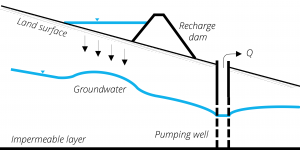
Recharge dams are impermeable structures built into stream channels that store stream runoff water by creating surface reservoirs upstream of the dam. They can be either designed to recharge the groundwater by enhancing surface water infiltration behind the recharge dam (as picture above) or by controlled release of water through the dam and downstream infiltration through the river bed.
| Typical system capacity scale | Village – Town (≈104m3/year – ≈106m3/year). |
| Geology | Unconfined aquifers. |
| Topography | Natural drainage channels, mainly on intermittent or ephemeral stream conditions. |
| Soils | Permeable river bed, sand gravel. |
| Water source | River water. |
| Pre-treatment | Silt traps may be used to mitigate clogging. |
| MAR main objective | Strategic water storage. |
| Relative cost | Low to moderate (depends on size of the dam). |
Advantages and disadvantages of the system (adapted from IGRAC, 2007):
Advantages
- Little interference with other land use.
- Storage of flash floods.
Limitations
- Dam failure may cause high damages downstream the dam.
Case studies
References
- IGRAC. (2007). Artificial Recharge of Groundwater in the World.
- DEMEAU. (2014). Characterization of European managed aquifer recharge (MAR) sites – Analysis.
